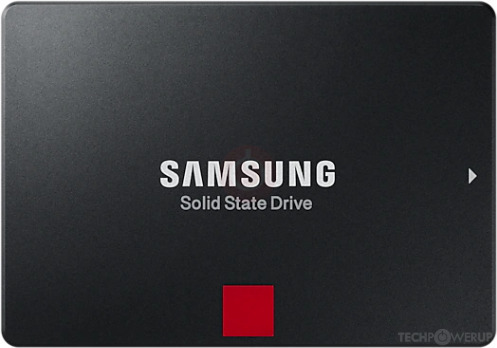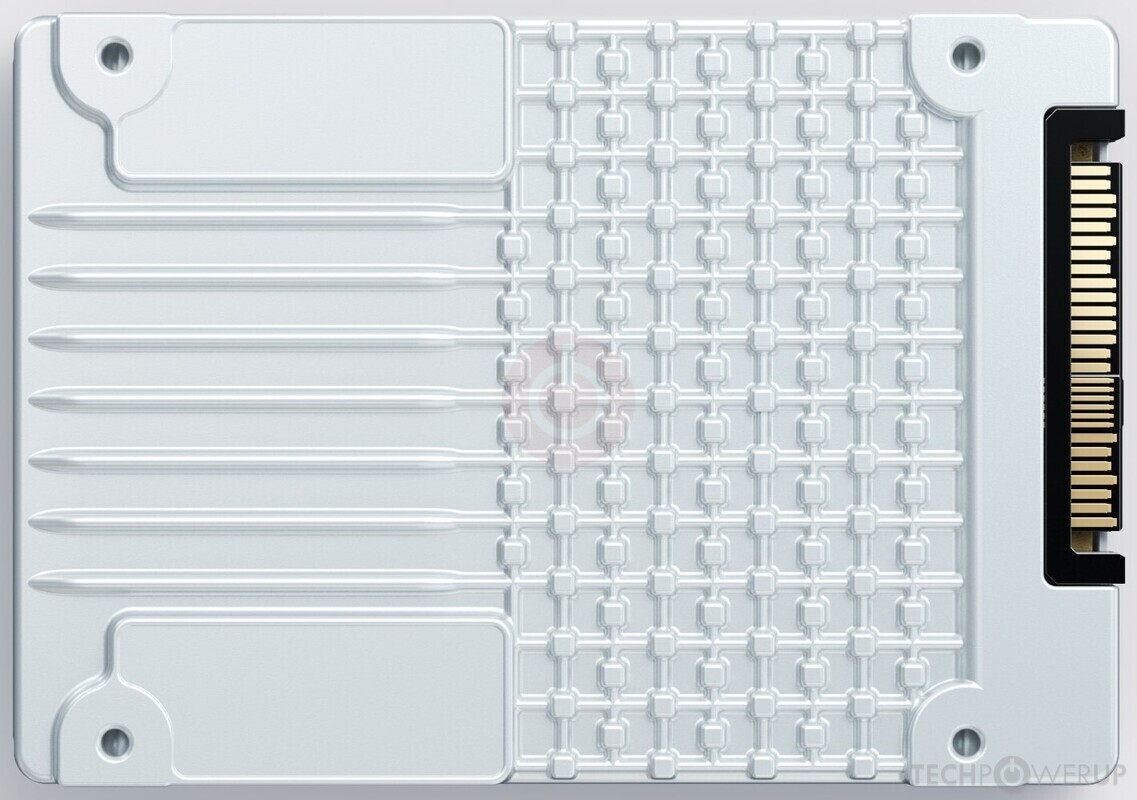TheLostSwede
News Editor
- Joined
- Nov 11, 2004
- Messages
- 18,472 (2.47/day)
- Location
- Sweden
| System Name | Overlord Mk MLI |
|---|---|
| Processor | AMD Ryzen 7 7800X3D |
| Motherboard | Gigabyte X670E Aorus Master |
| Cooling | Noctua NH-D15 SE with offsets |
| Memory | 32GB Team T-Create Expert DDR5 6000 MHz @ CL30-34-34-68 |
| Video Card(s) | Gainward GeForce RTX 4080 Phantom GS |
| Storage | 1TB Solidigm P44 Pro, 2 TB Corsair MP600 Pro, 2TB Kingston KC3000 |
| Display(s) | Acer XV272K LVbmiipruzx 4K@160Hz |
| Case | Fractal Design Torrent Compact |
| Audio Device(s) | Corsair Virtuoso SE |
| Power Supply | be quiet! Pure Power 12 M 850 W |
| Mouse | Logitech G502 Lightspeed |
| Keyboard | Corsair K70 Max |
| Software | Windows 10 Pro |
| Benchmark Scores | https://valid.x86.fr/yfsd9w |
Solidigm today announced the D7-5810, an enterprise SSD for extremely intensity write workloads. Such a drive would be capable of write endurance in the neighborhood of 50 DWPD. For reference, the company's D7-P5620, a write-centric/mixed workload drive for data-logging, and AI ingest/preparation, offers around 3 DWPD of endurance, depending on the variant; and the read-intensive drive meant for CDNs, the D5-P5336, offers around 0.5 DWPD. Use cases for the new D7-P5810 include high performance caching for flash arrays dealing with "cooler" data; high-frequency trading, and HPC.
Solidigm D7-P5810 uses SK hynix 144-layer 3D NAND flash that's made to operate in a pure SLC configuration. The drive comes in 800 GB and 1.6 TB capacities, and offers 50 DWPD over an endurance period of 5 years (4K random writes). More specifically, both models offer 73 PBW (petabytes written) of endurance. The drive comes in enterprise-relevant 15 mm-thick U.2 form-factor, with PCIe Gen 4 x4 interface, with NVMe 1.3c and NVMe MI 1.1 protocols.


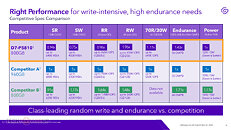

In terms of manufacturer-rated performance, Solidigm is claiming up to 865,000 IOPS 4K random reads (QD256), up to 495,000 IOPS 4K random writes (QD256), and response times of 13 µs for 4K sequential writes (QD1), and 10 µs sequential read at QD1. The drive offers up to 6.4 GB/s sequential reads (128K, QD128), and up to 4 GB/s sequential writes (128K, QD128). Solidigm D7-P5810 is being offered as a persistent write buffer, and a medium tiered above capacity-focused media such as the QLC-based Solidigm D5-P5336, the pure-SLC drive stores "data about data," under a cloud-storage acceleration layer (CSAL).
Solidigm is launching the D7-P5810 series with the 800 GB model, with the 1.6 TB model joining the lineup in the first half of 2024.


Solidigm, a leading global provider of innovative NAND flash memory solutions, is proud to announce the company's first ultra-fast, single-level cell (SLC) solid-state storage drive (SSD) for the data center market—the Solidigm D7-P5810. The D7-P5810 is a PCIe Gen 4.0 drive built on Solidigm's proven 144-layer SLC 3D NAND.
A new addition to Solidigm's high-performing D7 Series, the D7-P5810 is designed for high-endurance and extreme write-intensive workloads. This ultra-fast Storage Class Memory (SCM) SSD offers up to 50 Drive Writes Per Day (DWPD) for random, 65 DWPD for sequential, and up to 2X better performance than the competition for caching, high-performance computing (HPC), data logging, journaling, and more, at less than ~20% of the cost of non-NAND SCM technologies.
SLC as a Storage Accelerator
The D7-5810 is ideally suited as a storage accelerator in front of highly dense capacity tiers (like QLC-based SSDs), adding significant benefit in the following use cases:
"By introducing the D7-P5810, Solidigm has now further expanded its industry-leading endurance swim lane coverage. We are pleased to offer a new ultra-fast data center SSD with compelling specifications to serve customers' very high write-intensive needs," said Greg Matson, VP of Strategic Planning and Marketing at Solidigm.
The D7-P5810 is available now in 800 GB (U.2 15 mm form factor). A 1.6 TB version will be available in the first half of 2024.
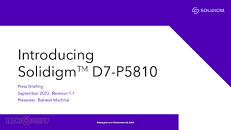






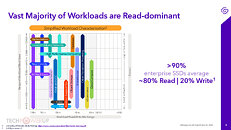
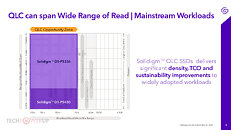


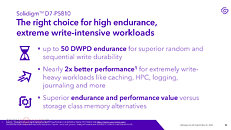


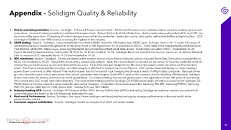
View at TechPowerUp Main Site | Source
Solidigm D7-P5810 uses SK hynix 144-layer 3D NAND flash that's made to operate in a pure SLC configuration. The drive comes in 800 GB and 1.6 TB capacities, and offers 50 DWPD over an endurance period of 5 years (4K random writes). More specifically, both models offer 73 PBW (petabytes written) of endurance. The drive comes in enterprise-relevant 15 mm-thick U.2 form-factor, with PCIe Gen 4 x4 interface, with NVMe 1.3c and NVMe MI 1.1 protocols.




In terms of manufacturer-rated performance, Solidigm is claiming up to 865,000 IOPS 4K random reads (QD256), up to 495,000 IOPS 4K random writes (QD256), and response times of 13 µs for 4K sequential writes (QD1), and 10 µs sequential read at QD1. The drive offers up to 6.4 GB/s sequential reads (128K, QD128), and up to 4 GB/s sequential writes (128K, QD128). Solidigm D7-P5810 is being offered as a persistent write buffer, and a medium tiered above capacity-focused media such as the QLC-based Solidigm D5-P5336, the pure-SLC drive stores "data about data," under a cloud-storage acceleration layer (CSAL).
Solidigm is launching the D7-P5810 series with the 800 GB model, with the 1.6 TB model joining the lineup in the first half of 2024.


Solidigm, a leading global provider of innovative NAND flash memory solutions, is proud to announce the company's first ultra-fast, single-level cell (SLC) solid-state storage drive (SSD) for the data center market—the Solidigm D7-P5810. The D7-P5810 is a PCIe Gen 4.0 drive built on Solidigm's proven 144-layer SLC 3D NAND.
A new addition to Solidigm's high-performing D7 Series, the D7-P5810 is designed for high-endurance and extreme write-intensive workloads. This ultra-fast Storage Class Memory (SCM) SSD offers up to 50 Drive Writes Per Day (DWPD) for random, 65 DWPD for sequential, and up to 2X better performance than the competition for caching, high-performance computing (HPC), data logging, journaling, and more, at less than ~20% of the cost of non-NAND SCM technologies.
SLC as a Storage Accelerator
The D7-5810 is ideally suited as a storage accelerator in front of highly dense capacity tiers (like QLC-based SSDs), adding significant benefit in the following use cases:
- Metadata/logging: placing performance-sensitive data such as metadata or logs on SLC can accelerate system performance by using SLC as a dedicated Write-Ahead Log in Ceph clusters, for example.
- Caching: SLC SSDs can act as a write buffer or cache to help remove performance bottlenecks, dramatically improve application performance, and improve TCO.
- Tiering: data is written first to the SLC SSD so commits are fast, and subsequent reads are faster. As data becomes colder, it can be aggregated, compressed, and written in bulk to underlying higher-capacity QLC drives (like Solidigm's D5-P5336) for space-efficient storage on that media. Write-shaping software such as Cloud Storage Acceleration Layer (CSAL), further delivers a solution that extends the density, TCO and sustainability value of QLC to more workloads.
"By introducing the D7-P5810, Solidigm has now further expanded its industry-leading endurance swim lane coverage. We are pleased to offer a new ultra-fast data center SSD with compelling specifications to serve customers' very high write-intensive needs," said Greg Matson, VP of Strategic Planning and Marketing at Solidigm.
The D7-P5810 is available now in 800 GB (U.2 15 mm form factor). A 1.6 TB version will be available in the first half of 2024.















View at TechPowerUp Main Site | Source



